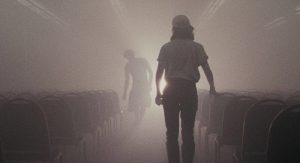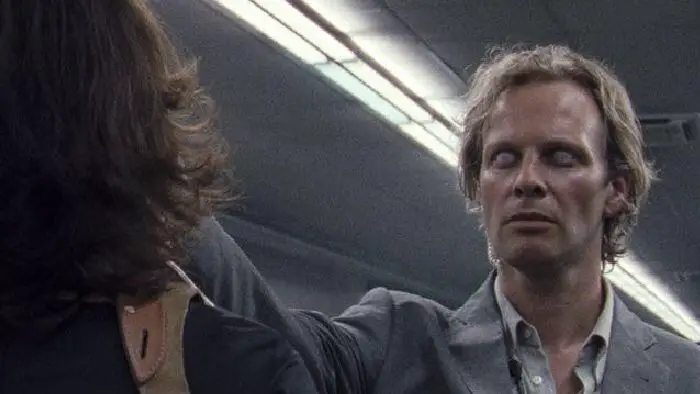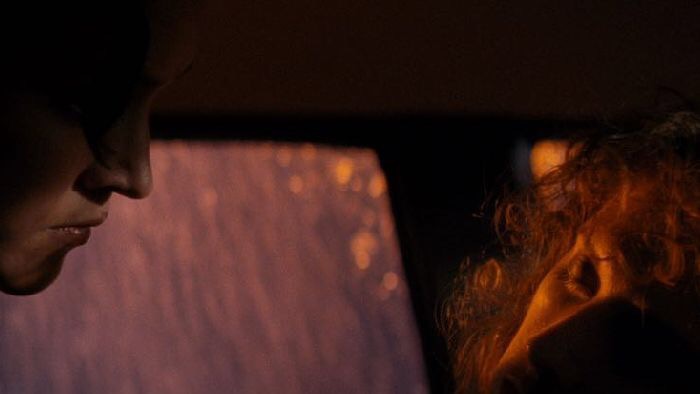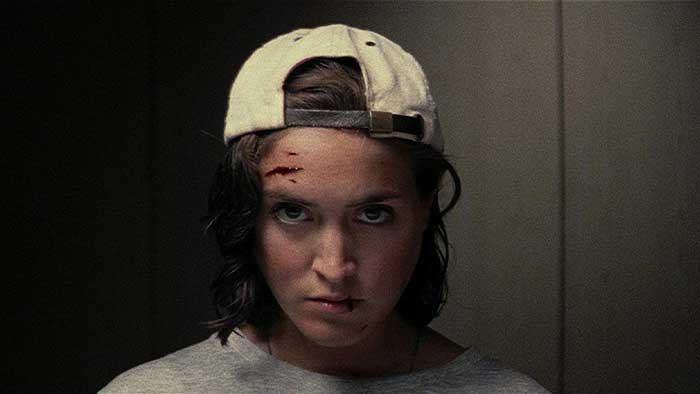
I was completely stunned after seeing Tilman Singer’s Luz, which is one of the absolute best films I’ve seen this year, was his thesis film for art school. The heavily stylized tale of possession of hypnosis is an absolute must-see for all horror fans. It takes place in Germany, where Luz, a cab driver, meets an old “friend” of hers, who has been searching for her ever since they first met in school. The two have an other-worldly connection that we learn more about as Luz is hypnotized by a doctor who is definitely not who he seems. The film is absolutely worth seeking out. I got to talk with Singer about the film and here’s what he had to say.
First of all, Luz is amazing. Where’d you get the idea for it in the first place?
Tilman Singer: So, Luz is my thesis film. I was studying at a school for the media arts, not really a film school, but there’s a film department. So my initial thought was that I wanted to do something longer than I had done before, around 6o minutes. Then I did some research on police sketch artists, the people who draw wanted or missing people, but no real story came of it. At least none that I could produce with the budget we had. But I stumbled across police interrogation techniques and eventually had notes that gave me a lot to work with. The first thing I had in mind was some version of the long middle scene, the hypnosis scene with the chairs. The chairs came later but my initial thought was of somebody who’s been hypnotized and relived what’s happened to that person before, and we can show all of that in one room which is really interesting. The nature of hypnotism is actually kind of scary to me–to be able to invade a person’s mind like that. That’s when the occult elements came to it. So from there I just built a story around that scene I had in mind and thought of the characters. Who are they? Why are they talking to each other and that’s how it came together.

“The nature of hypnotism is actually kind of scary to me–to be able to invade a person’s mind like that.”
The hypnotism part is really interesting to me, as well. I’ve known people who have gone to hypnotherapy and always just found it incredibly strange as well. But, where did you shoot the scenes for the police station? The building is just amazing. It looks like it’s straight out of the ’70s, which I loved.
I know! It was straight out of the ’70s, possibly the ’60s. We shot everything in Cologne, Germany. That’s where my art school was located and we were really lucky to get this very cheap from the city. It’s an abandoned office building that we actually never found out what was in there before. So it had all the wood paneling and of course the large room but they were all empty. So everything you see in there, this is what my production designer Dario (Mendez Acosta) and his team managed to come up with but I think they did a really great job making it feel organic within the structure that we found. We were really lucky though because Cologne is a city where a lot of people shoot television. So, everybody that has some buildings for rent for film shoots, they know that they can ask for a lot of money. It’s a huge problem for poor students who have none. So we were really lucky. Initially, our main set where we wanted to shoot the hypnosis scene had a bad pipe leak, there was sewage and everything, which we found out in the middle of shooting. So we had to look for another location in the middle of our shoot. Then, we actually came back to this building to shoot at the entrance. We only shoot the entrance, the corridor, and the stairs. Then we went back there to a different story of the building and shot the big scene in there. It actually turned out great and I don’t think the original room would have been as nice, so it was we were lucky with being unlucky.
I had read a little about this but wanted to hear from you, what kind of camera did you use to shoot Luz?
We used an Arriflex from Arri. It’s a 16mm camera and the cool thing is that we got some anamorphic and amorphic lenses. These cameras, like the Arriflex or the Arri Alexa, nowadays, more or less have a 16mm frame as a chip and then we’ll stick lenses on to shoot in 16 which is amazing.
It looks so hip, like I said, straight out of the ’70s. The visual quality makes it look very vintage, but then at the same time, you’re not entirely sure when the film takes place at all.
It was set in the past, but it was undefined for us. It was the early nineties or something. Clearly, we were going for something vintage, retro, or something and then because we shot on 16 and most shots are dolly shots, and that’s done so often, nowadays. So the feeling of you don’t know when it was shot comes naturally. I like it a lot.

“I didn’t mean to make something truly blasphemous.”
This is so funny to me and I’m wondering where you came up with the particular subversion of The Lord’s Prayer that Luz uses. Is it something that already existed or how did it come about?
At some point, and I don’t remember when it was, that Luz back in school summoned some kind of demon that from that point on was longing for her in some harmful, evil way. I remember we talked about this a lot with my core creative team, my production designer, my director of photography, my composer and we all agreed that she needed to have some kind of call that has to repeat itself. I didn’t mean to make something truly blasphemous. I didn’t grow up religious but I remember from elementary school, every now and then I’d have to go to the Catholic religion classes and sometimes they took us to church and all we did was learn prayers, like the Our Fathers and stuff. I remember the only thing we did was sit there and try to come up with different words to make it as funny as possible. So I found that to be very fitting for the film. Then also, my wife is Colombian, so she would translate everything that’s in Spanish for me from English, so she wrote this prayer for me. I don’t think we were that crude when we were children but maybe we were, we said more awful things.
I know now from talking to you that you’re coming at it more from an angle of hypnosis but as it became more about a demonic entity, did you study any real cases of demonic possession?
No, not really. I really focused on my research on hypnotism. I read books about and from the fathers of modern hypnotherapy. There’s a guy called Milton H. Erickson and I’ve read his stories with his patients. At least one book about him has his strategies of getting people into a trance, and we used that pretty accurately, with the doctor who’s doing the hypnosis in the film. So I concentrated more on that because I felt well equipped by watching all kinds of scary movies to reference that (possession).
That actually leads right into my next question which is what is your favorite horror film that focuses on possession?
I was just asked a similar question and I think it still counts. I was asked what my favorite horror film is, and I said The Thing. It kind of has a possession theme, if you would count switching out or infiltrating people’s bodies. All the body-snatcher films. Including Invasion Of The Body Snatchers, they all kind of begin with the same thing. Like you’re not really sure of people’s intentions or who they really are, and that all plays into it.

“…you’re not really sure of people’s intentions or who they really are, and that all plays into it.”
The score is amazing. Did you go to school with Simon Waskow? How much input did you have on the creation of the score?
Well, I agree with you that it’s really amazing. I’m a big fan of Simon. He’s a close friend. I actually went to high school with him so we met when were 14, I think, and we played in indie bands together and stuff like that. When I started making short films, he always composed music for them. So we’ve known each other for a very long time which is a great thing because we trust each other. I always give him a very early, not even a draft, just some notes about what I’m working on and then he comes up with things very early on. Especially for Luz because there’s, of course, part of the soundtrack that Luana (Velis) sang for so it had to be ready before we shot the scene. We knew we were going to take that melody somehow and transform it and put it in the rest of the score. It actually repeats I think, three times over the course of the film. So Simon gives me things to work with. When I edited Luz with a friend (Fabian Podeszwa), I remember sometimes giving them a temporary track that he can use as orientation because I just have to edit a very long scene. For example, the first bar scene had a Tangerine Dream track behind it, and from there Simon came up with those long, jazzy tracks that worked way better than the temporary track. Then other times, he just sent me demos that just might be him with a synthesizer trying to find a theme or a melody. Actually, I remember the scene where the demon comes out and he controls Luz after the hypnosis, and he changes into the dress. That actually was a piece that Simon wrote on Christmas Eve. It was just about eight minutes of him searching for melody and it fits perfectly with Dr. Rossini changing into different clothing and preparing for his new attempt at getting close to Luz and we just kept it. We tried to work it out better later but it wasn’t as good as that original instrumentation. So it comes from all kinds of places, the music, but yes it’s a very close collaboration.
What was it like working with Yellow Veil pictures? I know the guys just from the horror scene here in New York, and they’ve been putting out some really great stuff, this film included. So I wanted to know how you connected with them and how that all came together.
We connected pretty instantly. I know that at least two of them watched my film at the European Film Market at the Berlin Film Festival. Then maybe a month later we had a Skype with all three of them. They were just starting their company and Luz was going to be their first film. So I had to get my art school on board. They’re still credited as a producer on the film along with me and my production designer. Yellow Veil is super great. It just felt right. We pretty much immediately became friends after seeing each other at Fantasia in Canada and I’ve been close friends with them ever since. I couldn’t be happier to have them as the film’s representatives.
They really are a great company! I hope to get to go to Fantasia next year! It has so many great films coming out of it every year. Also, thank you so much for talking to me about Luz, it’s been one of my favorite films of the year so far and I can’t wait to see what you do next!

